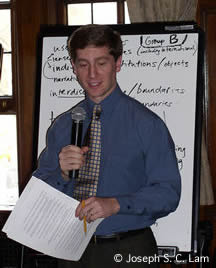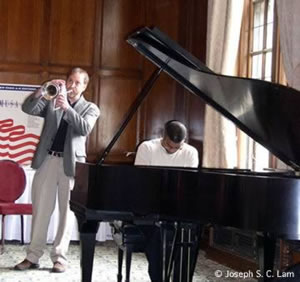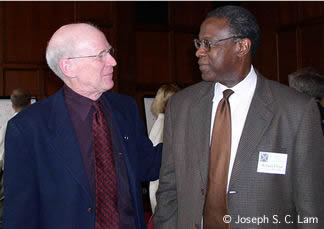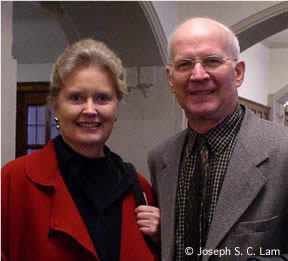Why did I wander, here and there and yonder,
Wasting precious time for no reason or rhyme?
Isn’t it a pity? Isn’t it a crime?
My journey’s ended; ev’rything is splendid.
Meeting you today has given me a wonderful idea, here I stay…
“Isn’t a Pity” (1932), music and lyrics by George and Ira Gershwin
Over the course of Richard Crawford’s storied career as scholar, writer, editor, teacher, and advocate for American music, the discipline he helped to found has spread across the country and beyond. At the time he chose to write his dissertation about the American psalmodist Andrew Law (1749–1821), however, it was considered professionally reckless, if not career-ending, to devote oneself to the study of American music. Nearly all of the field’s early pioneers, including H. Wiley Hitchcock, Crawford’s adviser at the University of Michigan, first established themselves in time-honored subject areas, such as Baroque or Renaissance music, before turning to music of the United States. Yet, Crawford’s unorthodox route has borne remarkable results. In 1962, shortly after Hitchcock left Ann Arbor for Hunter College, Crawford joined the Michigan faculty, where he remained and flourished for more than forty years. Crawford’s voluminous list of publications attests to his expertise in all eras of American music, united most recently in last year’s tour de force, America’s Musical Life: A History. While establishing Ann Arbor as a vital center for American music studies, Crawford also served as president of the American Musicological Society and encouraged that organization’s support of Music of the United States of America, a significant series of critical editions for which he continues to serve as editor-in-chief. Due in considerable part to the efforts of Crawford and his students, American music has grown into a recognized discipline, evidenced by the founding of the Society for American Music, the publication of thousands of books and scholarly articles in the field, and the substantial rise in course offerings and faculty positions in American music.
While Richard Crawford’s retirement from the University of Michigan this spring marks the end of an era, the conference held in his honor, Criss Cross: Conversations About American Music, proved to be equally concerned with the future of American music studies, a future that the proceedings suggested would be filled with debate and expansive possibilities. In his opening welcome, Mark Clague described how the conference title, taken from the name of a tune by Thelonious Monk, meant to serve several purposes. In addition to gesturing toward Crawford’s jazz scholarship, Criss Cross reflects the inter- and multi-disciplinarity of contemporary American music scholarship as well as the conference’s sustained attempt to foster cross-disciplinary conversations. Moreover, like both the retiring scholar and the iconoclastic jazz pianist, the conference itself took a novel approach toward established conventions for such occasions, keeping an eye on the future while commemorating past achievements.
Held on April 18–19, 2003, at the Michigan League on the UM campus in Ann Arbor, Criss Cross brought together nearly one hundred of Crawford’s colleagues from all stages of his career, including several dozen students, many of whom now hold their own faculty positions. Because of his wide-ranging contributions and his deserved reputation as one of the most amiable and encouraging voices in musicology, the conference also attracted a sizeable group of scholars with no direct Michigan affiliation. As a professor visiting from Vassar remarked, “I doubt Rich Crawford knows how much he’s meant to all of us.” By carving out musicological space and offering leadership in and out of the classroom, Crawford and the other Americanists of his era have made possible the present state of American music scholarship, even as subsequent generations revisit and revise the field.
Sponsored by a broad coalition of UM departments, study centers, and a student organization, the one-and-a-half-day conference exhibited the diversity of American music studies, its acceptance in musicological circles, and its appeal across disciplines and outside the academy. This became evident immediately from the opening three presentations: Joseph Horowitz’s address on the crisis of classical music in the U.S., Judith Tick’s discussion of feminist scholarship and American music, and Paul Anderson’s presentation on the Orphic impulse in contemporary R&B.

The conference featured a dozen talks by Crawford’s colleagues and students, who offered their visions on the past, present, and future state of the field. One refreshing feature was the incorporation of voices from outside American music, including Elaine Sisman, whose talk drew upon her expertise in the classical era as well as her recent task of reviewing the annual AMS conference. In addition to stressing the musicological benefits of detailed close readings, she proposed that Americanists might profitably study musical events that feature American performers regardless of repertoire, such as Marian Anderson’s striking version of Schubert’s “Erlkönig.” As part of the same session, Kay Kaufman Shelemay described what ethnomusicology continues to offer to the study of American music, while Samuel Floyd, Jr. contributed a spirited call for greater attention to the critical evaluation of American music. In addition to these direct challenges to the field as a whole, a special session devoted to the life, music, and sexuality of Leonard Bernstein led to several memorable moments of intellectual criss-crossing in the spirit of the conference.
In another sign of the conference’s uncommon inclusiveness, Saturday morning’s activities encouraged all attendees to participate.

To open an experimental session entitled “Core Repertories,” an allusion to several Crawford projects, Dale Cockrell hypothesized about what a Ph.D. program in American Music Studies would need to include. Conference-goers then split into five small groups to address individual case studies in American music historiography. I joined the jazz studies circle and listened to brief remarks from a few experts, followed by open discussion. After an hour or so, everyone reconvened to hear each group’s spokesperson summarize their findings. The entire process resulted in the compilation of an unordered wish list, including better cataloguing of U.S. sheet music, filling a variety of gaps in knowledge of American music history, and responding to the variety of epistemological challenges brought by U.S./Mexico border musics, globalization, 9/11, and immigration.
Ironically, it was the failure to achieve the stated goal of this unconventional activity—the formulation of a group statement about future directions of American music studies—that led to valuable, if unforeseen, benefits. The intimate working groups forced everyone to become more invested in the proceedings and kick-started conversations that continued throughout the day. Moreover, the liveliness of the ensuing full discussion, moderated admirably by Travis Jackson, became an opportunity to hear from a wide array of opinionated voices. The open forum as well as the future-directed nature of the conference also encouraged the audience to voice more troubling concerns for the field, including the rigidity of certain disciplinary and institutional boundaries, the scarcity of scholars of color in the field, and the potential effects of recent challenges to affirmative action, which have been felt especially vividly on the UM campus. Rather than simply marking the accomplishments of the field, the collective session symbolized, and began to catalog, just how much work remains to be done.

and Guthrie Ramsey (piano)
Much of the success of Criss Cross resulted from its singular nature and the labors of love that led to a series of stimulating presentations and performances. The collaborative, interdepartmental nature of the conference generated a sparkling musical display—mainly by current or former UM music faculty—including Arthur Greene’s thoughtful rendition of the Alcotts movement of Ives’s Concord Sonata, University of Iowa professor Alan Huckleberry’s ebullient version of the “Nightmare Fantasy Rag” from William Albright’s set of Dream Rags, and several jazz duets performed by Penn professor Guthrie Ramsey, a former Crawford advisee, and Edward Sarath, the chair of the UM Jazz Department. The event also profited from the efforts of the conference organizers, who gathered funding ample enough to provide free registration, abundant refreshments, a welcoming location, and an

affordable dinner banquet. A few simple scheduling decisions also made a large difference. True to its name, Criss Crossfacilitated conversations between conference-goers, since nearly all events were plenary functions held in the same oak-paneled room, separated by longer-than-average breaks that alleviated any need to rush. The less-is-more approach contributed to a general spirit of conviviality. As a result, I spent Saturday’s lunch discussing Rich Crawford’s impact and the future of American music studies with three scholars hailing from Philadelphia, Manhattan, and Ann Arbor, only one of whom I had met before.
As might be expected, plans are now underway to publish an edited volume containing revised versions of conference talks along with additional contributions. Just as its focus on epistemological, historiographical, and methodological challenges to the field of American music honors many of Crawford’s scholarly concerns, the volume’s proposed title, Rethinking American Music, signals the organizers’ intentions not to rest on Crawford’s laurels but to interrogate the state of the field and to spur further research. The conference’s embrace of technology, moving beyond a detailed website, also may prelude future academic developments. Similar to email listservs that foster post-conference discussions, the organizers of Criss Cross created an online discussion forum to facilitate ongoing conversations. Most significantly, anyone unable to attend Criss Cross need not wait for the proceedings to appear in printed form, since all conference presentations are available as Web-based audio recordings.
Despite their obvious benefits, the audio recordings fail to capture adequately the shifting waves of emotion—spirited celebration, wry nostalgia, and bittersweet melancholy—on the occasion of Crawford’s retirement. While speakers repeatedly expressed their gratitude, the task of formal recognition fell to H. Wiley Hitchcock, Crawford’s teacher, comrade, and dear friend. In the course of assessing Crawford’s achievements, Hitchcock offered private glimpses of a scholarly life well lived, drawing on personal anecdotes, correspondence and memorabilia that have accompanied the lasting friendship of two of the leading Americanists of their generation. His heartfelt commendation occasionally turned to good-natured—and meticulously documented—ribbing, most amusingly when he recalled Crawford’s written salute upon Hitchcock’s own departure from UM. Excerpts from Crawford’s poetic tribute,loosely and ironically modeled on Longfellow’s “Song of Hiawatha,” brought peals of unguarded laughter from the crowd, and inspired Tara Browner, one of Crawford’s protégés who specializes in Native American music, to compose and deliver a tribute of her ownlater that evening.

Crawford’s keynote address, the Criss Cross finale, emblematized his career in many respects—most plainly in its willingness to break convention and prove successful for just that reason. Delivered with his characteristically disarming aplomb, his talk began by covering the expected territory of a retirement address: snapshots of an academic life; memorable tales about and praise for former teachers, colleagues, students, friends and relatives; and a detailed account of his intellectual journey from psalmody to popular music. At this point, however, Crawford shifted gears, resuming his role as a teacher once more. The latter portion of his address offered a preview of his current book project on George Gershwin, as he led the audience in singing “Isn’t It a Pity?” before discussing a few renditions of the tune. The lyrics of this amusing yet sentimental song held their own tragicomic resonance for the occasion, (“Why did I wander, here and there and yonder / Wasting precious time?”, “My journey’s ended; ev’rything is splendid”), prompting some tears and sighs. But the tune’s optimistic narrative about two lovers who finally meet, along with Crawford’s decision to embody his pedagogical role, served to reassure the room that, although his formal career as a full-time professor may be over, he still has many valuable contributions to make to American music studies in the years to come.
The formal conference proceedings ended with the presentation to Crawford of a portrait of Duke Ellington, followed by a flurry of handshakes, hugs, and best wishes. Later that evening, most of the conference attendees reconvened on the top floor of a local Italian restaurant. Appropriately down-to-earth and informal, the evening celebration doubled as buffet-style banquet and light-hearted roast, filled with affectionate words, emotional tributes, and humorously playful toasts. Emceed winningly by Jeffrey Magee, who contributed his own music-filled homage to Crawford’s career, the festivities opened with a moving a capella performance by Amy Stillman of a traditional Hawaiian chant.

Crawford’s brother spoke gently of young Rich’s enthusiasm for coaching baseball and playing jazz saxophone, both of which displayed his Americanist tendencies yet also suggested that his eventual pursuit of musicology was a wise career move. His first Ph.D. student, Sterling Murray, then recalled showing his work to the young Crawford. Upon receiving a draft from his initial advisee, the junior professor grabbed his marking pen, placed his feet on his desk, lit a cigar, and began to read, pausing between puffs to ask thorny questions. Just for the record, Murray went on to finish his dissertation, and, fortunately for his later students, Crawford gave up cigars long ago.
Friendly jibes also came from bleary-eyed former students whose sleep suffered from Crawford’s regular habit of placing calls at 7:00 a.m., a few hours after the customary start of his work day. While Rich rolled his eyes and Penny Crawford, his wife and musical companion, laughed with delight, a parade of students offered similar paeans that revolved around important themes in the life of Crawford: personal and professional generosity; a wide, deep, and abiding love of American music; an unwavering commitment to teaching alongside his own example of productivity; consistently high standards for scholarship; and, last but not least, relentless prose editing (“Omit needless words!”; “No high-falutin’ talk!”; “Draft, draft again, then draft once more!”). At evening’s end, however, sentiment and symbolism outflanked wit in a touching tribute to Richard Crawford’s legacy. The retiring professor’s final four Ph.D. advisees presented him with a framed photograph depicting the quartet of scholars standing together against an Arizona desert landscape, taken on the occasion of the 2003 annual conference of the Society for American Music.
Charles Hiroshi Garrett
University of California, Los Angeles
My thanks go out to the Criss Cross conference organizers, in particular Mark Clague, who compiled many of the materials used in this review and provided detailed replies to my inquiries. Thanks as well to Joseph S.C. Lam for donating his photographs, Timothy Freeze for compiling the bibliography of Crawford’s publications, Tara Browner for her Crawfordian tribute, and H. Wiley Hitchcock for holding onto his copy of “Canto di Granoturco” for the past forty years.
